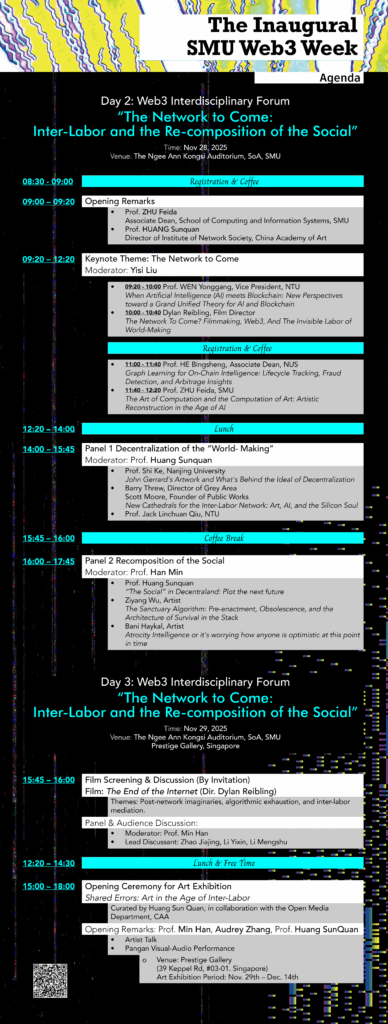感谢新加坡管理大学朱飞达教授的邀请,网络社会研究所能够以特别策划的形式加入 SMU Web3 Week (Nov. 27-30)的学术活动。年会特别场包含论坛与展览,集中在 Nov. 28-29 日 。
将临的网络:互为劳动与社会的重组
The Network to Come: Inter-Labor and the Recomposition of the Social
时间
2025年11月28-29日
(周五至周六)
地点
新加坡管理大学
The Ngee Ann Kongsi Auditorium, SoA, SMU
主办单位
新加坡管理大学计算与信息系统学院
协办与支持
中国美术学院跨媒体艺术学院(SIMA)
网络社会研究所(INS)
开放媒体系(OM Dept)
Prestige Gallery(新加坡)
会议总召
朱飞达 教授(新加坡管理大学 信息系统学院副院长)
黄孙权 教授(中国美术学院 网络社会研究所所长)
引言
继上海举办的第十届网络社会年会——「互联的终结?爱(AI)来不来?」之后,新加坡场次将目光转向那个被宣告存在于互联网终结之后的世界。此次活动新加坡管理大学计算与信息系统学院主办,由中国美术学院网络社会研究所合办,并得到 Prestige Art Gallery 的慷慨支持。我们非常高兴的可以成为 SMU Web3 Week 的特别活动之一。
上海场标志着一个转折点:我们意识到,曾经作为「开放」之隐喻的网络,已然变成了平台时代私有化和企业化的数据基础设施。新加坡场从这种疲惫中出发——可以说是翻过这一页——去思考在互联网的残余之中,新的劳动、关系和想象形式正如何悄然重组。我们提出(或许略显鲁莽地)一段名为「互为劳动」(Inter-labor)的理论旅行。
「互为劳动」指涉一种由三个相互交织的过程所构成的新历史条件。
首先,AI 并非外星的发明,而是人类集体的创造:每一个模型、数据集和参数都凝聚了人类推理、翻译、标注和想像的漫长历史。
其次,今天的人类与 AI 确实在一起工作,但这并非「共存」的和谐二重奏。相反,它们的关系形成了一种建模、提示、验证与维护的不平衡生态——机器的输出成为了随后人类工作的素材与约束。这既不是设计师想像中的「人机介面」,也不是「共生」这般未经批判的口号。
第三,也是最关键的一点,人类正日益「通过」AI 与彼此协作。这种由算法中介的互为劳动正在重构「社会」(The Social),并极有可能成为下一个「网络」的决定性特征。
AI 并未解放劳动,它重新分配了劳动。它让隐形劳动增殖,精炼可提取之物,并将注意力本身转化为新的基础设施。我们深知,每一个模型本质上都是集体劳动的记录——一个由清洗、权重、标注、修正和沉默所构建的语料库,全部被折叠进黑箱计算之中。AI 所谓的「智能」,实则是人类劳动的沉积物(sediment),是众多人类经由代码折射后的回响。谈论互为劳动,即是确认一种新的历史性:人类创造了一种镜像自身智能的机器——但它反映的不是个体,而是一个通过技术学习自身的社会身体。
在互为劳动中,「社会性」浮现了。人类不再仅仅是与 AI 一同工作,而是通过它工作。在此条件下,作者权、价值和照料(care)的边界变得模糊:隐形劳动支撑着可见的创造,算法秩序重写了价值的度量。由人创造、向人学习的 AI,反过来重写了人类共存的根本条件。
在此视角下,艺术重获了一种核心可能性。本世纪以来,艺术过多地臣服于技术决定论或政治正确的论述——被对技术错误和政治错误的双重恐惧所纠缠。然而,艺术仍是一种独特的人类遭遇世界的方法。它可以使交互劳动的肌理可见——展现其延迟、摩擦和偏差;它可以排演「反基础设施」(counter-infrastructures)——如民间档案、合成方言、慢计算;它可以预演新的团结与照料形式。
如果每一次计算都是一种构成(composition),那么策展、编码和组织就成为了「世界营造」(world-making)的技术。互联网(inter-net)之后是互为劳动的网络——一个不再以速度或规模衡量,而是以其「共同构成感知与记忆之脆弱关系」的能力来衡量的网络。因为人类当下正面临失去「世界营造」劳动本身的风险——我们失去的不是其基础,而是文化与欲望借以生成的运动本身。(文/黄孙权教授)
会议内容
11月28日(论坛): 将汇集理论家、艺术家和技术研究者,共同探索这一转型——从不可见劳动的经济学到算法的诗学,从云基础设施的地缘政治到共享能动性的艺术实践。
11月29日(放映与展览): 上午10点,Dylan 的影片《互联网的终结》(The End of Internet)放映,以此呼应上海场的主题;下午3点,展览《共误:互为劳动时代下的艺术》(Shared Errors: Art in the Age of Inter-Labor)将在 Prestige Gallery 开幕。本次展览由黄孙权教授策展,与中国美术学院跨媒体艺术学院开放媒体系师生合作完成。这场展览不是理论的补充,而是理论的试验场:通过数据、技术和感知的重构,艺术家们揭示了错误、延迟和重复如何成为新的认识论形式。在这里,艺术不回应技术,也不崇拜技术——它将技术揭示为一种当代社会经验的形式。
The Network to Come: Inter-Labor and the Recomposition of the Social
November 28–29, 2025, Singapore
Convener:
Prof. ZHU Feida, Associate Dean of School of Information Systems, SMU
Prof. HUANG Sunquan, Director of Institute of Network Society. China Academy of Art
Host by
School of Computing & Information Systems, Singapore Management University
Co-organized by
Institute of Network Society & Department of Open Media, School of Intermedia Art, China Academy of Art
Prestige Gallery, Singapore
By Prof. HUANG Sunquan
Following the 10th Annual Conference of Network Society in Shanghai—”The End of Connection? AI (Love) Coming or Not?”—the Singapore edition, co-organized by the Institute of Network Society, School of Intermedia Art, China Academy of Art, and the School of Computing and Information Systems, Singapore Management University, with generous support from Prestige Art Gallery, turns its gaze toward the world declared to exist after the end of the internet.
Shanghai marked a turning point: we realized that the network, once a metaphor of openness, has become the privatized and corporatized data infrastructure of the platform age. Singapore departs from this exhaustion—turning the page, as it were — to consider how, amid the residues of the internet, new forms of labor, relation, and imagination are quietly reassembling. We propose, perhaps recklessly, a new theoretical journey under the name inter-labor.
Inter-labor designates a new historical condition composed of three intertwined processes.
First, AI is not an alien invention but a collective human one: every model, dataset, and parameter condenses the long history of human reasoning, translation, annotation, and imagination.
Second, humans and AI do indeed work together today, but not as a harmonious dyad of “coexistence.” Rather, their relation forms an uneven ecology of modeling, prompting, verification, and maintenance — where mechanic outputs become both the material and the constraint of subsequent human work. This is neither the “human-machine interface” imagined by designers, nor the uncritical slogan of “symbiosis.”
Third, and most crucially, humans increasingly work with one another through AI. This algorithmically mediated inter-labor is reconfiguring the social, and may well become the defining feature of the next network to come.
AI does not liberate labor; it redistributes it. It proliferates the invisible, refines what can be extracted, and converts attention itself into a new infrastructure. We know that every model is, in truth, a record of collective work—a corpus built from cleaning, weighting, labeling, correction, and silence, all folded into black-box computation. The so-called “intelligence” of AI is the sediment of human labor, the echo of the many refracted through code. To speak of inter-labor is thus to recognize a new historicity: humanity has created a machine that mirrors its own intelligence—yet one that reflects not individuals, but a social body learning itself through technology.
Within inter-labor, “The Social” emerges.Humans no longer merely work
with AI, but through it. Under these conditions, the boundaries of authorship, value, and care blur: invisible labor sustains visible creation, and algorithmic order rewrites the measure of worth. AI — created by humans, learning from humans—has in turn rewritten the very conditions of human coexistence.
From this vantage, art regains a kind of core possibility. Since the beginning of this century, art has too often submitted to the discourses of technological determinism or political correctness — haunted by the fear of technical error and the fear of political error alike. Yet art remains a distinct human method of encountering the world. It can render visible the textures of inter-labor—its delays, frictions, and deviations; it can rehearse counter-nfrastructures — folk archives, synthetic dialects, slow computation; and it can prefigure new solidarities and forms of care.
If every computation is also a composition, then curating, coding, and organizing become techniques for world-making. After the inter-net comes the inter-labor network—a network that may no longer be measured by speed or scale, but by its capacity to co-compose the fragile relations of perception and memory. For humanity now stands at risk of losing the labor of world-making itself—not its foundation, but the very movement through which culture and desire have always come into being.
On November 28, the Forum will bring together theorists, artists, and researchers in technology to explore this transformation—from the economies of invisible labor to the poetics of algorithms, from the geopolitics of cloud infrastructures to artistic practices of shared agency.
On November 29, we will screen Dylan’s Film “ The End of the Internet” at 10 am,and the exhibition “Shared Errors: Art in the Age of Inter-Labor” opens at 15:00 at Prestige Gallery. Curated by Huang SunQuan, in collaboration with the faculty of the Open Media Department, School of Intermedia Art, China Academy of Art
, This exhibition is not a supplement to theory but its trial ground: through reconfigurations of data, technology, and perception, artists reveal how error, delay, and repetition can become new epistemic forms. Art here does not respond to technology, nor worship it — it exposes technology as a contemporary form of social experience.
会议日程(年会部分)

工作团队
会议组
黄孙权|刘怿斯|
周蓬岸|李梦书|赵佳菁|李艺欣
策展组
黄孙权 | 蔡宇潇|武子杨|曹澍|阚梓菡|钱可奕
